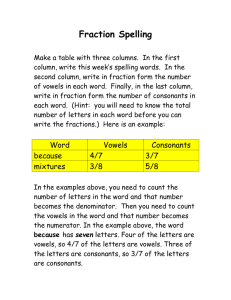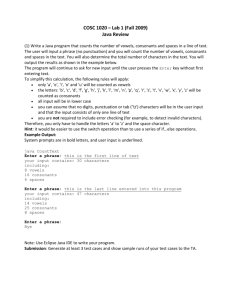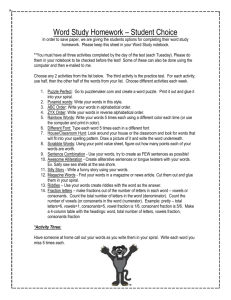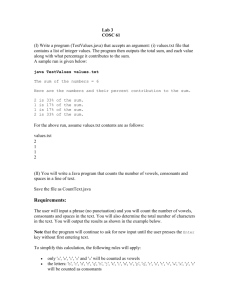INTERVENTION STRATEGY: - Weld RE
advertisement
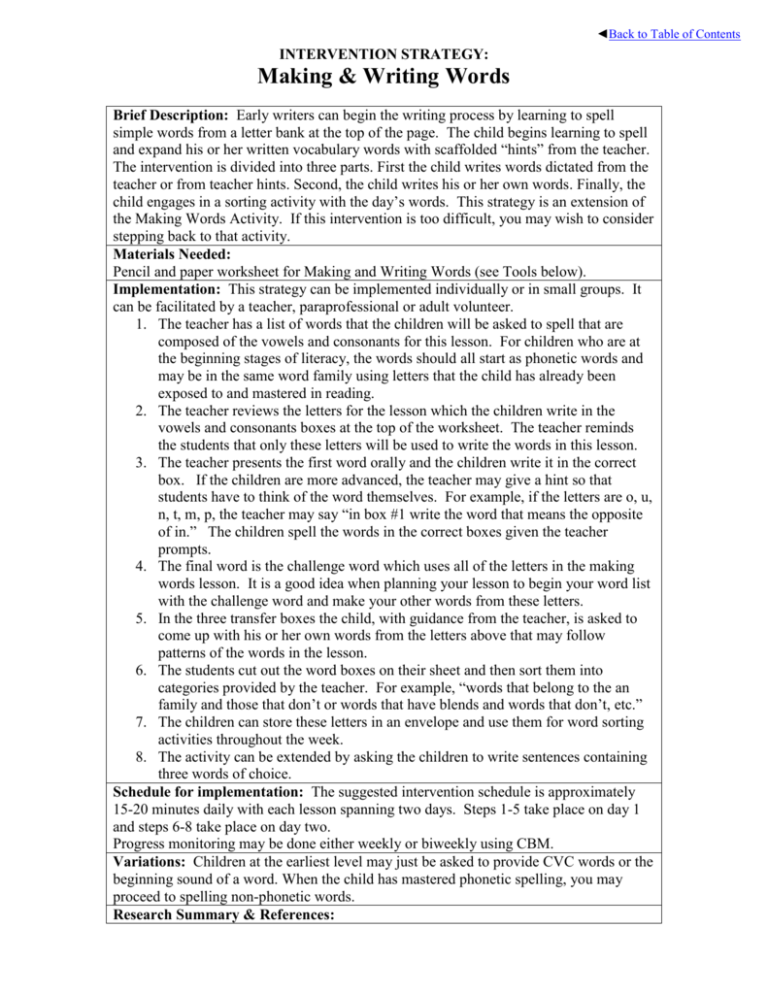
◄Back to Table of Contents INTERVENTION STRATEGY: Making & Writing Words Brief Description: Early writers can begin the writing process by learning to spell simple words from a letter bank at the top of the page. The child begins learning to spell and expand his or her written vocabulary words with scaffolded “hints” from the teacher. The intervention is divided into three parts. First the child writes words dictated from the teacher or from teacher hints. Second, the child writes his or her own words. Finally, the child engages in a sorting activity with the day’s words. This strategy is an extension of the Making Words Activity. If this intervention is too difficult, you may wish to consider stepping back to that activity. Materials Needed: Pencil and paper worksheet for Making and Writing Words (see Tools below). Implementation: This strategy can be implemented individually or in small groups. It can be facilitated by a teacher, paraprofessional or adult volunteer. 1. The teacher has a list of words that the children will be asked to spell that are composed of the vowels and consonants for this lesson. For children who are at the beginning stages of literacy, the words should all start as phonetic words and may be in the same word family using letters that the child has already been exposed to and mastered in reading. 2. The teacher reviews the letters for the lesson which the children write in the vowels and consonants boxes at the top of the worksheet. The teacher reminds the students that only these letters will be used to write the words in this lesson. 3. The teacher presents the first word orally and the children write it in the correct box. If the children are more advanced, the teacher may give a hint so that students have to think of the word themselves. For example, if the letters are o, u, n, t, m, p, the teacher may say “in box #1 write the word that means the opposite of in.” The children spell the words in the correct boxes given the teacher prompts. 4. The final word is the challenge word which uses all of the letters in the making words lesson. It is a good idea when planning your lesson to begin your word list with the challenge word and make your other words from these letters. 5. In the three transfer boxes the child, with guidance from the teacher, is asked to come up with his or her own words from the letters above that may follow patterns of the words in the lesson. 6. The students cut out the word boxes on their sheet and then sort them into categories provided by the teacher. For example, “words that belong to the an family and those that don’t or words that have blends and words that don’t, etc.” 7. The children can store these letters in an envelope and use them for word sorting activities throughout the week. 8. The activity can be extended by asking the children to write sentences containing three words of choice. Schedule for implementation: The suggested intervention schedule is approximately 15-20 minutes daily with each lesson spanning two days. Steps 1-5 take place on day 1 and steps 6-8 take place on day two. Progress monitoring may be done either weekly or biweekly using CBM. Variations: Children at the earliest level may just be asked to provide CVC words or the beginning sound of a word. When the child has mastered phonetic spelling, you may proceed to spelling non-phonetic words. Research Summary & References: The following references may be consulted to learn the essentials and variations of this strategy: Cunningham, P.M. & Cunningham, J.W. (1992). Making-Words: Enhancing the invented spelling-decoding connection. The Reading Teacher, 46, 106- 115. Rasinski, T. (1999). Making and writing words. Reading Online, an electronic journal of the International Reading Association. Available at http://www.readingonline.org/articles/words/rasinski_index.html. Rasinski, T. & Oswald, R. (2005). Making and writing words: Constructivist word learning in a second-grade classroom. Reading & Writing Quarterly, 21,151-163. Tool/Attachments: The files entitled “Making & Writing Words” & “Making & Writing Words 3rd & up” in the TOOLS folder on this disk contains the MWW worksheet that can be printed for educational purposes with the permission of the author. Here is an example of what a completed making words activity might look like. Possible teacher prompts are in italics. What the student would write is in bold: Making and Writing Words Vowels Consonants o i u 1. “Write the word tin.” c s 2. “Write the word ton.” t t n n r 3. “Write the word sin.” ton tin 4. “Write the word rut.” c 5. “Write the word crust.” sin 6. “A penny, a nickel and a dime are all _____. Write the word for round metal money.” rut coin crust 7. “If I leave my bike outside it 8. “I use a spoon to ______ the will _______. That means it will turn orange the gears won’t move.” cake mix so all of the ingredients are mixed well.” rust stir 11. “When I want to know how 10. “If I am sad I am ______ happy.” 9. “Write the word trust.” trust 12. “Write the word for the much something is, I ask the clerk how much does it ____?” bright yellow ball in the sky that provides light and heat for the earth.” cost sun not 13. “Write the word that is the 14. “When camping I sleep on a 15. (The Challenge Word) opposite of in” ___. It is smaller than a bed, but better tan sleeping on the ground.” out cot “Write the word that means building a structure like a house or school from something from materials like bricks or lumber. Our new school is just being built. It is under ___________” construction T-1 coins T-2 cots T-3 sort Here is an example of what a completed making words activity for a beginning writer might look like. Teacher prompts are in italics. What the student would write is in bold: Making and Writing Words Vowels Consonants e i 1. “Write the word tin.” t t 2. “Write the word ten.” 5. “Write the word met.” set 7. “Write the word mit.” 8. “Write the word stem.” 6. “Write the word net.” net 9. “Write the word nest.” stem 11. “Write the word mist.” test 13. “Write the word time.” sit met mit 10. “Write the word test.” s n 3. “Write the word sit.” ten tin 4. “Write the word set.” m nest 12. “Write the word mine.” mist 14. “Write the word tent.” time tent mine 15. (The Challenge Word) “ You wear these on you hands when it is cold. We just read a story where the main character lost one in the woods and a bunch of animals went inside of it.” mittens T-1 tents T-2 times T-3 nets ◄Back to Table of Contents


